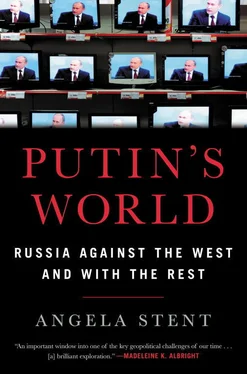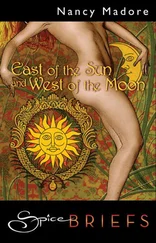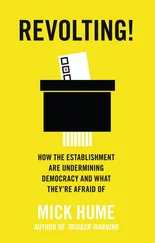When Chechen separatists declared their independence and Moscow sent troops to crush their movement, Iran opted not to aid them and supported Russia’s territorial integrity. Tehran also cooperated with Moscow to end the civil war in Tajikistan, whose population is largely Shia. Iran worked with Russia to support the forces of the Northern Alliance in Afghanistan, who opposed the Taliban. These pressing domestic and regional concerns argued for a cooperative relationship with Iran. 8
Vladimir Putin had launched the Second Chechen War in 1999 when he was prime minister under Yeltsin, and his presidency began with a focus on managing Russia’s Muslim population. His Middle East policy has been informed by the domestic imperative to contain and prevent future separatist and terrorist movements emanating from the North Caucasus. He has also worked to foster comity with Russia’s Muslims. He has on several occasions stressed that, unlike Europe or the United States, where Muslims are immigrants, Russia’s Muslims are indigenous. In 2003, he attended the summit of the Organization of the Islamic Conference in Malaysia and declared that “Muslims are an inalienable part of the people of Russia.” 9In 2005, Russia was granted observer status at the organization and remains an active participant. In a 2005 speech to the Chechen parliament, Putin stated: “Russia has always been the most faithful, reliable, and consistent defender of the interests of the Islamic world.” 10
Under Putin, Russia steadily began to restore its ties with the Arab world, as it also built up its relationships with Israel and Turkey. In 2002, it became part of the Quartet on the Middle East—consisting of the United States, Russia, the EU, and the UN—formed to find a solution to the Arab-Israeli dispute. The group has met only intermittently, and Russia’s role has never been as prominent as that of the United States, but it remains a formal player in this process. For Russia, stability in the Middle East is a major concern because of the Middle East’s ability to export instability to Russia and its neighbors.
During Putin’s first term, the most contested aspect of Russia’s Middle East policy was its decision to oppose the US-led invasion of Iraq and side with Germany and France in condemning US actions. Russia’s relationship with Iraq was deep and complex, involving lucrative oil and arms contracts, and Moscow also saw Saddam Hussein as a bulwark against the growing influence of Iran and of Shiite fundamentalism. Russia had always argued, contrary to the United States, that Iraq did not have weapons of mass destruction and had urged a peaceful solution to the Iraqi problem. In the run-up to the war, the United States apparently assumed that Russia would support its position and spent little time consulting with Moscow about its plans. Three weeks before the invasion, Putin, seeking to prevent any military action, sent Primakov to Baghdad to try to persuade Saddam to step down from the presidency and call elections. Saddam responded with a series of accusations against Russia and walked out of the room. 11
Still hoping to broker a deal that would avoid war, Putin sent Alexander Voloshin, head of the presidential administration, to Washington to explain the Russian position to US officials. He concluded that Washington mistakenly believed Russia’s only interest in Iraq was economic, because American officials combined their briefings on Saddam’s alleged WMD programs with offers to compensate Russia for economic losses it might sustain as a result of the invasion. Voloshin tried to explain to his hosts that Russia feared an invasion of Iraq could destabilize Russia’s southern neighbors and fuel extremism and terrorism—which, in hindsight, was quite prescient. 12When it became clear that the Bush administration was determined to pursue regime change in Iraq, Russia responded to German and French overtures and joined the “coalition of the unwilling” in opposing a UN resolution authorizing the use of force against Saddam. Putin denounced the military campaign as illegal, accusing the United States and its allies of replacing international law with “the law of the fist.” 13The invasion of Iraq and the subsequent military campaign adversely affected Russia’s economic interests in the country. It also ultimately led to the rise of Islamic State (IS). By disbanding the Iraqi army, the US created a disgruntled group of armed Iraqis searching for revenge—and IS became their haven. But for Putin, the most troubling aspect of the invasion was the US commitment to regime change in the name of democracy. It was a short distance from Saddam’s execution to the outbreak of Middle Eastern color revolutions and to the Arab Spring.
THE ARAB SPRING
On December 10, 2010, Tunisian police seized a fruit-seller’s cart—and his livelihood. He set himself on fire to protest government repression and corruption, and the flames he ignited sparked a popular uprising against the Tunisian government. One month later, the dictator who had ruled Tunisia for twenty-three years had fled, and in the blink of an eye, the regional status quo began to collapse. Popular discontent against authoritarian leaders and the poverty their corruption inflicted on their citizens erupted all over the Middle East. In February 2011, after only eighteen days of protests in the central Tahrir Square, Egypt’s president Hosni Mubarak, who had ruled Egypt for thirty years, resigned under pressure from the United States. After a hastily arranged election, he was subsequently succeeded by Mohammed Morsi, leader of the Muslim Brotherhood. Libya followed suit with protests erupting in February 2011. Seven months later, Muammar Gaddafi, the eccentric leader who had ruled Libya for forty-two years, was dead, shot by an angry mob as he emerged from a sewer. Also in February 2011, a gaggle of schoolboys in a Syrian border town decided to play a prank and used red paint to spray the slogan “The people want the downfall of the regime” on their schoolyard wall. After they were arrested and beaten, outraged citizens demanding change began to protest all over the country. By the time Gaddafi was dead, the popular uprising against Syria’s Bashar al-Assad had developed into a full-scale civil war. A region that, prior to 2010, was ruled by autocrats who had maintained relative stability for decades with an iron hand, was in the throes of rebellion against the status quo.
From the Kremlin’s point of view, this was no Arab spring, but an Arab winter. Popular protests had brought down long-serving autocrats, and fundamentalist groups were on the rise. The precedent of color revolutions toppling corrupt authoritarian regimes was disconcerting. Moreover, the fact that these revolts were largely carried out in the name of Islam had potentially serious implications for Russia’s own Muslim population. And the prospect of instability in a region of strategic importance to Russia increased Moscow’s concerns about instability in its immediate neighborhood, in the predominantly Muslim countries of Central Asia that until 1991 had been part of the Soviet Union. Privately, Russian officials expressed not merely disbelief but incomprehension that the United States had abandoned its long-time ally Hosni Mubarak in favor of unknown and potentially dangerous Islamists.
From Putin’s point of view, one of the most disturbing aspects of these upheavals was what happened in Libya. Russia had a considerable economic stake in Libya. After forgiving Tripoli’s Soviet-era $4.5 billion debt in April 2008, Russian firms signed new oil and construction deals amounting to $10 billion, and arms sales continued to be an important part of the relationship. Moscow had traditionally been reluctant to jeopardize its influence in this part of the world by taking punitive actions against its partners. But during the Medvedev interregnum and the US-Russia “reset,” there appeared to be more flexibility in the Russian position. The West was growing increasingly concerned about the turmoil in Libya and the mounting casualties. Vice President Joseph Biden sought to convince Medvedev to support the anti-Gaddafi forces in order to end the bloodshed.
Читать дальше












